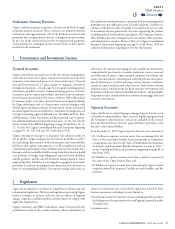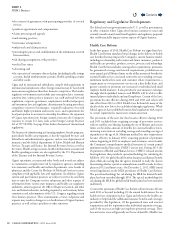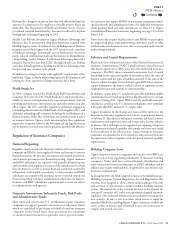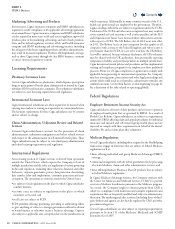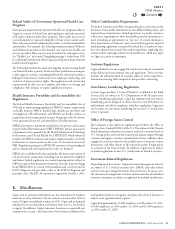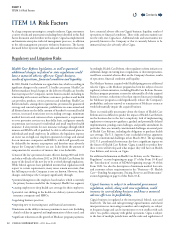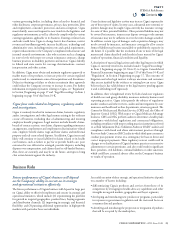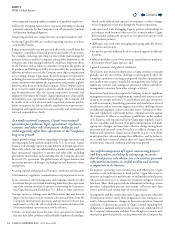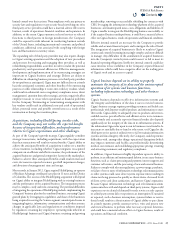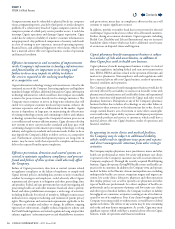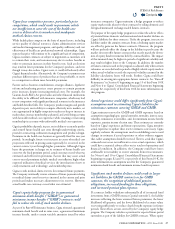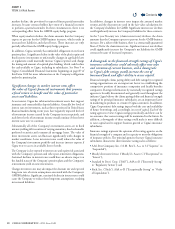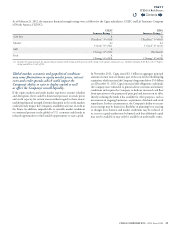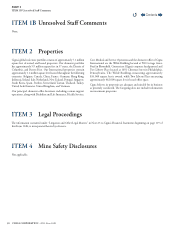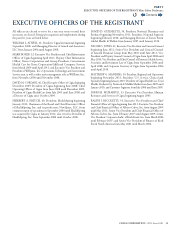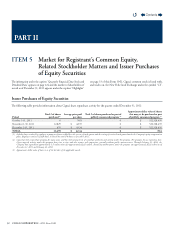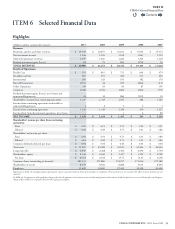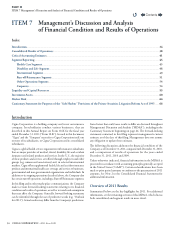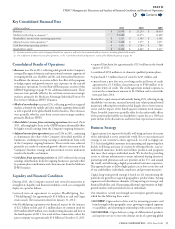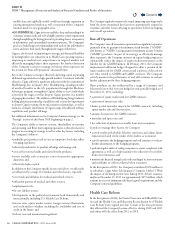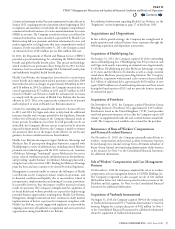Cigna 2011 Annual Report Download - page 49
Download and view the complete annual report
Please find page 49 of the 2011 Cigna annual report below. You can navigate through the pages in the report by either clicking on the pages listed below, or by using the keyword search tool below to find specific information within the annual report.
27CIGNA CORPORATION2011 Form10K
PARTI
ITEM 1A Risk Factors
Cigna faces competitive pressure, particularly price
competition, which could result in premiums which
are insufficient to cover the cost of the health care
services delivered to its members and inadequate
medical claims reserves.
While health plans compete on the basis of many factors, including
service quality of clinical resources, claims administration services
and medical management programs, and quality, suciency and cost
eectiveness of health care professional network relationships, Cigna
expects that price will continue to be a signicant basis of competition.
Cigna’s customer contracts are subject to negotiation as customers seek
to contain their costs, and customers may elect to reduce benets in
order to constrain increases in their benet costs. Such an election
may result in lower premiums for the Company’s products, and even
though it may also reduce Cigna’s costs, it could still adversely aect
Cigna’s nancial results. Alternatively, the Company’s customers may
purchase dierent types of products that are less protable, or move
to a competitor to obtain more favorable premiums.
Factors such as business consolidations, strategic alliances, legislative
reform and marketing practices create pressure to contain premium
price increases, despite increasing medical costs. For example, the
Gramm-Leach-Bliley Act gives banks and other nancial institutions
the ability to be aliated with insurance companies, which may lead
to new competitors with signicant nancial resources in the insurance
and health benets elds. e Company’s product margins and growth
depend, in part, on its ability to compete eectively in its markets, set
rates appropriately in highly competitive markets to keep or increase its
market share, increase membership as planned, and avoid losing accounts
with favorable medical cost experience while retaining or increasing
membership in accounts with unfavorable medical cost experience.
Cigna’s protability depends, in part, on its ability to accurately predict
and control future health care costs through underwriting criteria,
provider contracting, utilization management and product design.
Premiums in the health care business are generally xed for one-year
periods. Accordingly, future cost increases in excess of medical cost
projections reected in pricing cannot generally be recovered in the
current contract year through higher premiums. Although Cigna
bases the premiums it charges on its estimate of future health care
costs over the xed premium period, actual costs may exceed what was
estimated and reected in premiums. Factors that may cause actual
costs to exceed premiums include: medical cost ination; higher than
expected utilization of medical services; the introduction of new or
costly treatments and technology; and membership mix.
Cigna records medical claims reserves for estimated future payments.
e Company continually reviews estimates of future payments relating
to medical claims costs for services incurred in the current and prior
periods and makes necessary adjustments to its reserves. However,
actual health care costs may exceed what was estimated.
Cigna’s equity hedge program for its guaranteed
minimum death benefits (“GMDB”) or guaranteed
minimum income benefits (“GMIB”) contracts could
fail to reduce the risk of stock market declines.
As part of its Run-o Reinsurance business, Cigna reinsured a guaranteed
minimum death benet and in some cases, a guaranteed minimum
income benet, under certain variable annuities issued by other
insurance companies. Cigna maintains a hedge program to reduce
equity market risks related to these contracts by selling domestic and
foreign-denominated exchange-traded futures contracts.
e purpose of the equity hedge program is to reduce the adverse eects
of potential future domestic and international stock market declines on
Cigna’s liabilities for these contracts. Under the program, increases in
liabilities under the annuity contracts from a declining equity market
are oset by gains on the futures contracts. However, the program
will not perfectly oset the change in the liability in part because the
market does not oer futures contracts that exactly match the diverse
mix of equity fund investments held by contractholders. e impact
of this mismatch may be higher in periods of signicant volatility and
may result in higher losses to the Company. In addition, the number
of futures contracts used in the program is adjusted only when certain
tolerances are exceeded and in periods of highly volatile equity markets
when actual volatility exceeds the expected volatility assumed in the
liability calculation, losses will result. Further, Cigna could have
diculty in entering into appropriate futures contracts. See “Run-o
Reinsurance” in SectionG beginning on page15 of this Form10-K
and Note6 to Cigna’s Consolidated Financial Statements beginning
on page82, respectively of this Form10-K for more information on
this program.
Actual experience could differ significantly from Cigna’s
assumptions used in estimating Cigna’s liabilities for
reinsurance contracts covering GMDB and GMIB.
Cigna estimates reserves for GMDB and GMIB exposures based on
assumptions regarding lapse, partial surrender, mortality, interest rates,
volatility, reinsurance recoverables, and, for minimum income benet
exposures, annuity income election rates. ese estimates are currently
based on Cigna’s experience and future expectations. Cigna monitors
actual experience to update these reserve estimates as necessary. Cigna
regularly evaluates the assumptions used in establishing reserves and
changes its estimates if actual experience or other evidence suggests
that earlier assumptions should be revised. ere is a risk that Cigna’s
estimated reserves are not sucient to cover actual experience, which
could have a material adverse eect on its results of operations and
nancial condition. In addition, the Company could have losses
attributable to its inability to recover amounts from retrocessionaires.
See Notes6 and 10 to Cigna’s Consolidated Financial Statements
beginning on pages82 and 91, respectively of this Form10-K, for
more information on assumptions used for the Company’s guaranteed
minimum death benet and minimum income benet exposures.
Significant stock market declines could result in larger
net liabilities for GMDB contracts or for GMIB
contracts, the recognition of additional pension
obligations, increased funding for those obligations,
and increased pension plan expenses.
If a contract holder withdraws substantially all of its mutual fund
investments from a GMDB contract (“partial surrender”), the liability
increases reecting the lower assumed future premiums, the lower
likelihood of lapsation, and the lower likelihood of account values
recovering suciently to reduce death benet exposure in future
periods. ese eects are not covered by the Company’s equity hedge
program. e Company calculates a provision for expected future partial
surrenders as part of the liability for GMDB contracts. When equity
Contents
Q


